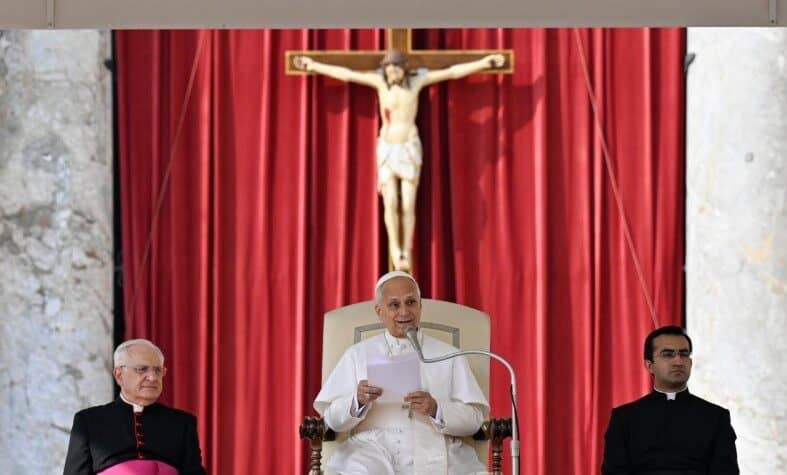Back in 2002, at the peak of the sexual abuse crisis in the American church, then-Bishop Wilton Gregory of Belleville, Ill., at the time the president of the US bishops’ conference, was in Rome. Every journalist on the planet wanted an interview, and my friend Jim Bittermann from CNN was lucky enough to score one.
I asked Bittermann if I could tag along to his appointment at the North American College, the American seminary in Rome, figuring it was the only way I would get access to Gregory on that trip. (Even though I worked for a competing publication, I was a regular on CNN.) Bittermann agreed, and so we set off.
We got as far as the inner courtyard at the NAC, which is where we ran into the unmovable Sister Mary Ann Walsh, the US bishops’ media coordinator.
Walsh immediately sniffed out the ruse, and wasn’t happy about it. She looked at Bittermann scornfully and said, “What, aren’t you man enough to do this by yourself? You need somebody to hold your hand?”
I was sternly exiled outside to wait for Bittermann to finish, and never did get my face time with Gregory until much later in the game.
That was one face of Sister Mary Ann, who could play the part of tough-as-nails nun to perfection when she felt the situation required it.
Walsh died on Tuesday at 68 after a battle with cancer, and it’s unlikely the American bishops will ever have a more ferociously protective media aide.
On the other hand, Walsh could also be one of the most gracious people on earth when she didn’t feel someone was trying to game the system, or was taking unfair potshots at the Church or the bishops.
During the run-up to the conclave in 2013 that elected Pope Francis, I was working more or less ‘round the clock both for my newspaper at the time, the National Catholic Reporter, and for CNN. At one stage, the network asked Walsh to make a guest appearance, and she dutifully showed up around 2 a.m. to go live during prime time back in the States.
Mary Ann had been working feverishly, too, and when she arrived at the CNN location, she looked exhausted and on the brink of collapse. Still, she made a point of asking the producer where I was, located the trailer I was resting in, came in unannounced (waking me up, by the way), simply to tell me that I was making American Catholics proud.
Coming from her, it was among the most meaningful bits of praise I ever received.
That was “Sister Mary Ann,” as the press corps called her. She was the kind of friend you’d always cherish, and the kind of enemy you’d wake up in the middle of the night dreading.
Walsh joined the Sisters of Mercy in 1964, and developed a fluency with the media. She helped coordinate media relations for St. John Paul II’s 1993 trip to Denver for World Youth Day, and then moved into the role that would define her for two decades: director of media relations for the United States Conference of Catholic Bishops (USCCB).
We in the media styled Walsh as the “bishops’ spokesperson,” though most of us actually knew better.
The USCCB is not the Vatican in miniature, and there is no “American pope.” The conference can’t claim to speak on behalf of all American bishops, and so Mary Ann was forever scrambling to keep up with whatever a given bishop had just said that appeared to undercut earlier statements from fellow prelates, or, for that matter, from the conference itself.
Walsh served the bishops during titanic battles between the Church and the Clinton administration over population control, the American sexual abuse crisis, the aftermath of 9/11, and the onset of the ‘War on Terror’, two papal elections, and the recent tug-of-war with the Obama administration over contraception mandates.
Through it all, she exuded competence, loyalty, and a deep understanding of the challenges facing the media – as well as, it must be said, a notoriously short fuse when we got the story wrong.
Walsh was no wide-eyed naïf about the Catholic Church. Privately, she chafed against a perceived “glass ceiling” for women and the hierarchy’s treatment of nuns, and she sometimes lamented that the bishops’ engagement on behalf of the poor and other social justice concerns didn’t generate as much heat as their positions on the culture wars.
Yet she was also a quintessential woman of the Church, in that she had a deep and abiding faith and understood that for every frustration she might feel at any given moment, there was also a powerful case for hope. She devoted her life to making sure those stories were told.
Toward the end, Walsh left her position with the bishops and took up a role as a columnist and blogger for America magazine. For journalists who occasionally sparred with her over the years, it felt like a homecoming, because deep down we always knew she was one of us.
The bishops will, of course, have other spokespersons, but they’ll never have another one quite like Sister Mary Ann. She said she wanted to be a bridge between the Church and the media, and perhaps the final proof of her success is that both camps today feel like they’ve lost a friend.















